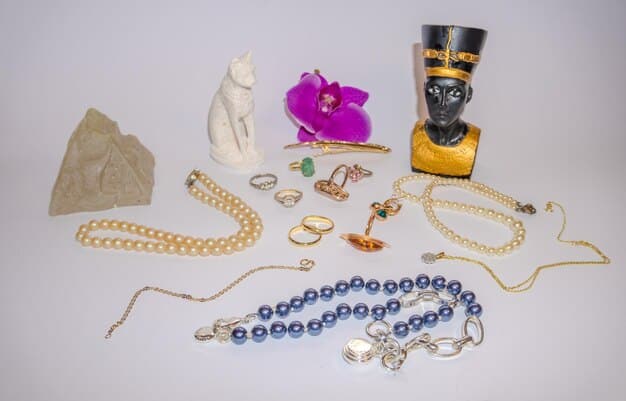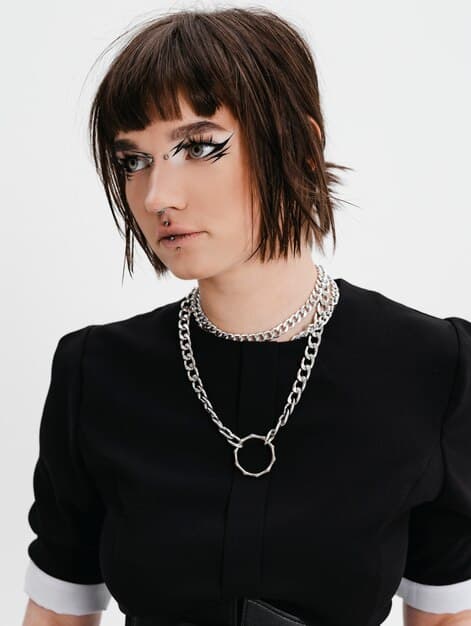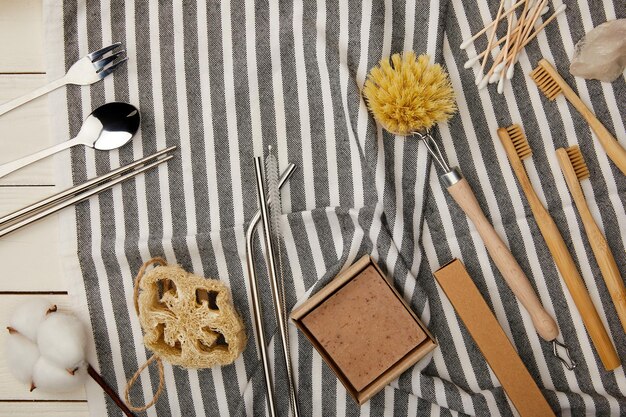The Ultimate Guide to Jewelry: Choosing the Right Pieces to Complement Your Style

This comprehensive guide offers expert insights into selecting jewelry that enhances individual style, exploring various types, materials, and design principles to ensure every piece complements personal aesthetics and occasions, empowering readers to make informed and confident choices.
Embarking on the journey of accessorizing your personal style can be both exhilarating and daunting, especially when navigating the vast and luminous world of jewelry. This exploration, The Ultimate Guide to Jewelry: Choosing the Right Pieces to Complement Your Style, will demystify the art of jewelry selection, transforming uncertainty into a confident embrace of personal expression.
Understanding Your Personal Style
Understanding your personal style is the cornerstone of building a cohesive and expressive jewelry collection. It’s not just about trends; it’s about what truly resonates with you and reflects your essence. Begin by observing your existing wardrobe and the aesthetics you gravitate towards. Do you prefer clean lines and minimalist designs, or are you drawn to vibrant colors and intricate patterns?
Defining your style can be broken down into several identifiable categories, each suggesting a particular approach to jewelry. Are you the classic type, favoring timeless elegance and subtle sophistication? Or perhaps your heart belongs to bohemian chic, embracing natural elements, layered textures, and a free-spirited vibe. Maybe your style leans modern and edgy, opting for bold geometric shapes and unconventional materials. Identifying these foundational elements helps streamline your jewelry choices, ensuring each piece harmonizes with your overall aesthetic rather than clashing.
Exploring Different Style Archetypes
Different style archetypes often dictate the types of jewelry that will best complement your look. For instance, someone with a romantic style might lean towards vintage-inspired pieces, pearls, or delicate floral motifs. In contrast, an individual with a sporty or casual style might prefer simple, durable pieces like leather wrap bracelets or stud earrings that don’t hinder movement.
It’s also crucial to consider the events and occasions for which you typically dress. Your everyday jewelry will likely differ significantly from pieces reserved for special events. This practical assessment helps you build a versatile collection that serves all aspects of your life.
- Classic & Timeless: Pearls, diamond studs, simple gold or silver chains.
- Bohemian & Free-Spirited: Layered necklaces, natural stone pieces, antique silver.
- Minimalist & Modern: Geometric shapes, sleek metals, single delicate pieces.
- Glamorous & Bold: Statement necklaces, chandelier earrings, large cocktail rings.
Ultimately, understanding your personal style is an evolving process. It involves self-reflection, experimentation, and a willingness to step outside your comfort zone while staying true to your core aesthetic. This introspection creates a foundation upon which you can confidently build a jewelry collection that genuinely represents you. When you know your style, choosing the right pieces becomes an intuitive and enjoyable experience, leading to a wardrobe that feels authentically yours.
The ABCs of Jewelry Materials
Delving into the world of jewelry materials reveals a fascinating spectrum of choices, each with its unique properties, aesthetic appeal, and symbolic value. From precious metals to gleaming gemstones and innovative alternative materials, understanding these fundamentals is key to making informed selections that truly complement your style and lifestyle. The durability, care requirements, and even the emotional resonance of a piece are often dictated by its composition.
Precious Metals: Gold, Silver, and Platinum
Gold remains a timeless classic, valued for its luster and versatility. Available in various karats (a measure of purity), it ranges from the rich warmth of yellow gold to the subtle elegance of white gold and the romantic hue of rose gold. Each offers a distinct aesthetic, allowing for diverse stylistic pairings. Silver, particularly sterling silver, provides an affordable yet equally beautiful alternative, known for its cool, bright gleam. It’s incredibly versatile and suits a wide range of skin tones and styles. Platinum, the most durable and rarest of the three, is cherished for its exceptional strength, natural white sheen, and hypoallergenic properties, making it an ideal choice for everyday wear and sensitive skin.
Consider the interplay of metals with your skin tone. Warm skin tones often pop with yellow or rose gold, while cooler tones are enhanced by silver, white gold, or platinum. However, these are merely guidelines; personal preference always prevails.
- Yellow Gold: Traditional, warm, classic; pairs well with warmer skin tones.
- White Gold/Platinum: Modern, cool, sleek; complements cooler skin tones.
- Rose Gold: Romantic, contemporary, unique; versatile for many complexions.
Gemstones: Color, Cut, and Clarity
The allure of gemstones lies in their vibrant colors, mesmerizing cuts, and unique clarity. Diamonds, emeralds, rubies, and sapphires are amongst the “precious” gemstones, admired for their rarity and brilliance. Beyond these, a vast array of “semi-precious” stones, like amethyst, peridot, topaz, and garnet, offers an incredible palette of colors and affordability. When selecting gemstones, consider the “4 Cs” for diamonds (Carat, Cut, Color, Clarity) and similar principles for colored stones, focusing on the intensity of color and the quality of the cut, which dramatically impacts their sparkle. The cut of a stone influences its brilliance and how it reflects light, while its color can dramatically impact its visual appeal and ability to complement different outfits.
The choice of gemstone can also reflect personal meaning, birthstones being a prime example. Understanding the symbolic meanings behind certain stones can add another layer of personal significance to your jewelry collection.
Alternative Materials: Modern and Sustainable Choices
Beyond traditional metals and gemstones, the modern jewelry market embraces an exciting range of alternative materials. These include edgy options like titanium and stainless steel, known for their durability and contemporary appeal, as well as eco-friendly choices such as recycled metals and responsibly sourced wood. Ethical considerations are increasingly influencing consumer choices, leading to a rise in demand for sustainable and conflict-free materials. Materials like ceramic, silicone, and even upcycled components offer unique textures, colors, and design possibilities, catering to a more avant-garde or lifestyle-driven aesthetic. These alternatives allow for greater creativity and personal expression, moving beyond conventional boundaries to truly reflect individual style. The growing popularity of lab-grown diamonds, which are chemically identical to mined diamonds but come with a more sustainable and ethical footprint, also represents a significant shift in the material landscape.
Choosing the right materials involves balancing aesthetic appeal with practical considerations such as daily wear, maintenance, and ethical sourcing. Each material tells a story, and knowing these stories allows you to curate a collection that is both beautiful and meaningful.
Choosing Necklaces: Framing Your Face and Neckline
Selecting the perfect necklace transcends mere adornment; it’s about strategically framing your face and enhancing your neckline. A well-chosen necklace can accentuate your best features, draw attention to your décolletage, and effortlessly elevate an outfit. The key lies in understanding the interplay between necklace length, style, and your clothing’s neckline. This symbiotic relationship ensures harmony and visual balance, making your overall look appear thoughtfully curated rather than haphazard.
Necklace Lengths and Their Impact
Necklaces come in a myriad of lengths, each designed to drape differently and create distinct visual effects. Chokers, sitting snugly around the neck, draw attention upwards to the jawline and neck. Princess length (18 inches) is perhaps the most versatile, resting elegantly just below the collarbone, making it suitable for almost any neckline. Matinee length (20-24 inches) falls gracefully over clothing, ideal for professional or casual attire, adding a touch of sophistication. Opera length (28-36 inches) is highly versatile, able to be worn long, doubled, or even knotted for a dramatic statement. Lastly, rope length (over 36 inches) offers maximum flexibility, perfect for layering or creating a cascading effect.
The length you choose should also align with the focal point you wish to create. Shorter necklaces highlight the collarbone and neck, while longer ones can elongate the torso and draw the eye downwards, creating a lean silhouette.
- Choker (14-16 inches): Sits high on the neck, emphasizing the jawline.
- Princess (18 inches): Rests on the collarbone, versatile for many necklines.
- Matinee (20-24 inches): Falls at the bust line, good for everyday wear.
- Opera (28-36 inches): Can be doubled or knotted, creates a statement.
Matching Necklaces to Necklines
The symbiotic relationship between a necklace and a neckline is paramount. A crew neck often benefits from a longer necklace that creates a vertical line, visually elongating the neck. For V-necks, a pendant necklace that mirrors the shape of the neckline is an excellent choice, drawing the eye downwards in a pleasing manner. Sweetheart necklines, with their curved design, pair beautifully with delicate, shorter necklaces that sit just above the curve. Strapless or off-the-shoulder tops provide a blank canvas, allowing for statement necklaces or chokers to truly shine.
Avoid necklaces that compete directly with the neckline of your garment. For instance, a very intricate necklace with a busy patterned top might lead to visual clutter. Instead, aim for complementary shapes and proportionate sizes. The goal is to create balance and enhance your outfit, not overwhelm it. The right necklace choice can transform a simple outfit into a fashion statement, or it can subtly add sophistication to an already elegant ensemble.
The material and style of the necklace also play a role. A delicate chain with a small pendant might be perfect for a minimalist look, while a bold, sculptural piece could be the ultimate accessory for a modern, artistic ensemble. Considering your personal aesthetic alongside the practicalities of necklines ensures that your chosen necklace truly complements your style, adding that final, polished touch.

Earrings: Complementing Your Face Shape
Earrings are often considered minor accents, yet their power to transform and enhance your facial features is immense. The art of choosing the right earrings lies in understanding your face shape and selecting styles that complement its natural contours. This thoughtful approach can soften angles, add width where needed, or elongate your appearance, creating a visually harmonious look. It’s about finding earrings that don’t just hang there, but actively enhance your unique facial architecture.
Identifying Your Face Shape
Before diving into earring styles, take a moment to identify your face shape. Stand in front of a mirror, pull your hair back, and trace the outline of your face with lipstick or a washable marker. Common face shapes include oval, round, square, heart, and long (rectangular).
For an oval face, considered the most versatile, almost any earring style works well. Round faces benefit from long, dangling, or angular earrings that help to elongate the face, counteracting its natural fullness. Square faces, characterized by a strong jawline and broad forehead, are beautifully softened by rounded, hoop, or teardrop earrings. Heart-shaped faces, with a wider forehead and narrower chin, can be balanced with chandeliers or teardrop earrings that are wider at the bottom to add fullness to the jawline. Long or rectangular faces are best complemented by studies, short dangles, or cluster earrings that add width rather than length.
Here is a quick guide to popular earring types and their general suitability for different face shapes:
- Stud Earrings: Universally flattering, particularly good for long faces.
- Hoop Earrings: All sizes, can add softness to square faces.
- Dangle/Drop Earrings: Elongate round faces, suitable for most, but avoid overly long for long faces.
- Chandelier Earrings: Excellent for heart-shaped faces, adds drama to oval.
- Teardrop Earrings: Softens square faces, adds width for heart-shaped.
Beyond Face Shape: Hair, Hairstyle, and Occasion
While face shape is a primary consideration, don’t overlook other factors like your hair length, hairstyle, and the occasion. Long hair might obscure delicate stud earrings, making bolder or dangling styles a better choice. Conversely, a short haircut can highlight intricate stud or small hoop earrings. Updos beautifully showcase shoulder-duster or chandelier earrings, drawing attention to the neck and décolletage. For daily wear, comfort and practicality might lead you to choose smaller, lighter earrings. However, for a formal event, a more elaborate, statement pair can complete a glamorous look.
The metal and gemstone of your earrings should also harmonize with your outfit and other jewelry. Mixing metals can be chic, but consider if it truly enhances your ensemble. Ultimately, the best earrings are those that make you feel confident and beautiful, reflecting your personal style and bringing out your best features. They are the perfect finishing touch, adding sparkle and personality to any look.
Bracelets and Rings: Hand and Wrist Coordination
Bracelets and rings, though often seen as secondary to necklaces and earrings, play a crucial role in curating a complete jewelry ensemble. These pieces adorn the hands and wrists, areas that are constantly in motion and often draw attention. The key to mastering their selection lies in understanding balance, proportion, and how they interact with each other and your overall style. Effective hand and wrist coordination transforms mere accessories into integral elements of your personal statement.
The Art of Stacking Bracelets
Stacking bracelets has evolved into a popular expression of personal style, allowing for creative combinations of texture, color, and material. However, there’s an art to achieving a look that is stylishly eclectic rather than chaotic. Start with a foundational piece, perhaps a classic watch or a simple bangle, and build around it. Mix and match different widths, from delicate chains to chunky cuffs, to create visual interest. Incorporate various materials like leather, beads, and different metals to add dimension.
Consider the occasion: a subtle stack of thin bangles is suitable for office wear, while a bolder, more varied stack might be perfect for a casual weekend outing or a bohemian-inspired look. Remember to leave some space on your wrist; overcrowding can diminish the impact of individual pieces. The goal is a curated collection that reflects your personality and effortlessly complements your outfit.
Choosing Rings: From Statement to Subtle
Rings offer a vast canvas for self-expression, ranging from minimalist bands to dramatic cocktail rings. When selecting rings, consider their size relative to your fingers and hands. Larger hands can carry off bolder, more substantial rings, while smaller, more delicate hands might be overwhelmed by them. A single statement ring can be a powerful focal point, drawing attention to your hands. Alternatively, a collection of delicate stacking rings worn across multiple fingers creates a modern, layered look.
Consider your finger length and overall hand shape. Long, slender fingers can carry off almost any style, while shorter fingers might benefit from elongated designs that create an illusion of length. Bands that are thinner can also make fingers appear longer.
- Statement Rings: One bold piece per hand can create a focal point.
- Stacking Rings: Mix thin bands with varying textures and stones for a dynamic look.
- Everyday Rings: Simple, durable bands that can withstand daily wear.
- Cocktail Rings: Reserved for special occasions, large and often colorful.
Coordinating Hands and Wrists
The synergy between your bracelets and rings can significantly elevate your overall jewelry aesthetic. If you’re wearing a strong statement cuff on one wrist, you might opt for more delicate rings on the same hand to maintain balance. Conversely, if your rings are the main event, keeping your bracelets simple or even opting for none can highlight them effectively. The key is to avoid competing focal points within the hand and wrist area.
The metals and stones should also ideally complement each other, although purposeful mixing of metals can be a very chic choice. Ultimately, selecting bracelets and rings is about creating a cohesive narrative for your hands and wrists that adds depth and personality to your style. These pieces, though small, contribute significantly to your overall look, reflecting your attention to detail and personal flair.
Curating Your Jewelry Collection for Versatility
Curating a jewelry collection that offers versatility is an essential strategy for maximizing your investment and ensuring you always have the perfect piece for any occasion. A versatile collection isn’t about owning an overwhelming quantity of items, but rather a thoughtfully selected assortment that can be mixed, matched, and adapted to various outfits and events. It’s about building a foundational wardrobe of jewelry that serves you well across different facets of your life, from casual outings to formal gatherings.
Building a Core Collection
Start by identifying the essential pieces that form the backbone of any versatile jewelry collection. These are the timeless items that transcend trends and seamlessly integrate into multiple looks. Think about classic pieces like a simple gold or silver chain, a pair of diamond or pearl stud earrings, and perhaps a delicate bracelet. These foundational items can be worn individually for a minimalist aesthetic or serve as the base for layering with more trend-driven or statement pieces. The objective is to select high-quality, durable items that you can wear consistently without them feeling dated or out of place.
When selecting core pieces, consider their adaptability. A single strand of pearls can go from an office meeting to an elegant dinner party. A classic watch can complement both casual jeans and a formal suit. These items are the silent workhorses of your jewelry box, providing a solid foundation upon which you can build.
Mixing High and Low, Old and New
One of the most effective strategies for a versatile collection is the art of mixing high-end, investment pieces with more affordable, fashion-forward items. A classic diamond pendant can be layered with a trendy costume necklace for an unexpected, personalized look. Similarly, incorporating vintage finds alongside contemporary designs adds character and a sense of history to your style. This blend creates a unique aesthetic that feels authentic and not overly curated. It also allows you to experiment with current trends without committing to significant financial outlays, keeping your style dynamic and fresh.
Thinking About Occasion and Lifestyle
Your lifestyle and the types of occasions you frequent should heavily influence your curation strategy. If your daily life is active and casual, durable, low-maintenance pieces like simple stud earrings or a leather bracelet might be preferred. For someone who regularly attends formal events, having a few statement pieces—such as a bold cocktail ring or an elegant chandelier earring—is more practical and necessary. The goal is to have a range of options that cater to your real-world needs, ensuring your jewelry always complements your current engagement.
A versatile jewelry collection allows you to express your evolving style without constantly needing new purchases. It’s about smart choices, understanding material longevity, and finding pieces that resonate with your authentic self. The truly versatile collection provides endless possibilities for self-expression, ensuring your jewelry is always an extension of who you are, effortlessly complementing every facet of your life. It ensures every piece has a purpose, a story, and a place in your evolving style journey.
Jewelry Care and Storage: Preserving Your Shine
Beyond the thrill of selecting the perfect pieces, understanding proper jewelry care and storage is paramount to preserving their beauty, integrity, and longevity. Neglecting these aspects can lead to tarnishing, damage, or loss, diminishing the value and appeal of your cherished items. Investing time in proper maintenance ensures your jewelry continues to shine brightly for years to come, allowing you to enjoy your collection fully.
Daily Habits for Jewel Longevity
Adopting simple daily habits can significantly extend the life of your jewelry. Always put your jewelry on after applying cosmetics, perfumes, and hairspray, as chemicals in these products can dull metals and damage porous gemstones. Similarly, remove jewelry before engaging in activities that could expose it to harsh chemicals (like cleaning) or physical impact (like sports or heavy lifting). Chlorine, for instance, can be particularly damaging to gold and silver. Even seemingly innocuous tasks like washing dishes can introduce abrasives or chemicals that are harmful.
Regularly wipe down your jewelry with a soft, lint-free cloth after each wear to remove oils and dirt. This simple step prevents buildup and keeps your pieces sparkling. For more intricate items, a gentle cleaning solution specifically designed for jewelry can be used, but always check the manufacturer’s recommendations for specific materials.
Proper Cleaning Techniques
Different materials require different cleaning approaches. For most gold and silver pieces without gemstones, a mild soap and warm water solution, applied with a soft brush, can be effective. Rinse thoroughly and dry completely with a soft cloth. For pieces with gemstones, especially softer or porous ones like pearls, opals, or turquoise, avoid harsh chemicals or ultrasonic cleaners, which can cause damage. Instead, gently wipe with a damp cloth and air dry. Pearls should never be submerged in water or cleaned with abrasive materials, as their delicate nacre can be easily scratched.
Ultimately, when in doubt, consult a professional jeweler for cleaning and maintenance advice, especially for valuable or antique pieces. They can provide specialized care and even re-polish metals or inspect settings to prevent stone loss.
Smart Storage Solutions
How you store your jewelry directly impacts its condition. Tossing pieces into a drawer can lead to tangling, scratches, and damage. Instead, store each item separately, ideally in soft pouches, lined jewelry boxes, or individual compartments. This prevents pieces from rubbing against each other, which can cause abrasions.
Humidity and air exposure contribute to tarnishing, particularly for silver. Consider anti-tarnish strips or storing silver in airtight bags. For pearls and opals, a slightly humid environment is better than one that is overly dry, as extreme dryness can cause them to crack. Always store jewelry away from direct sunlight and extreme temperatures, which can fade gemstones and weaken metal settings.
- Individual Storage: Prevent scratches and tangles by storing pieces separately.
- Environmental Control: Protect from humidity, direct sunlight, and extreme temperatures.
- Regular Wiping: Remove oils and dirt after each wear with a soft cloth.
- Professional Cleaning: For delicate or valuable pieces, seek expert care periodically.
By integrating these care and storage practices into your routine, you ensure that your jewelry remains as vibrant and beautiful as the day you acquired it, serving as a lasting testament to your style and memories. This commitment to care reflects a true appreciation for the craft and artistry embodied in each piece.

| Key Aspect | Brief Description |
|---|---|
| ✨ Personal Style | Identify archetypes (classic, bohemian) to guide your choices. |
| 💎 Materials Matter | Understand metals and gemstones for durability and aesthetic. |
| 📏 Fit & Form | Match necklaces to necklines, earrings to face shape for harmony. |
| 🎨 Curation & Care | Build a versatile collection and maintain it with proper storage. |
Frequently Asked Questions About Choosing Jewelry
Determining your personal jewelry style involves self-reflection on your existing wardrobe and general aesthetic preferences. Observe if you gravitate towards classic, minimalist, bohemian, or glamorous looks. Consider the colors, textures, and silhouettes you frequently choose. Your lifestyle and the occasions you dress for also play a significant role. This introspection helps pinpoint your core style, guiding your jewelry selections to effortlessly complement your overall appearance.
To start a versatile jewelry collection, focus on timeless pieces that can be dressed up or down. Essential items include simple gold or silver stud earrings, a delicate chain necklace (18-20 inches), and a classic bracelet (like a simple bangle or chain). These pieces can be worn individually for a subtle look or layered and combined with more statement items as your collection grows. Their simplicity ensures they complement a wide range of outfits.
Matching necklaces to necklines involves understanding their complementary shapes. For V-necks, choose pendants or necklaces that mirror the V-shape, drawing the eye down. Crew necks benefit from longer necklaces that create a vertical line. Strapless or off-the-shoulder tops are ideal for statement necklaces or chokers. Avoid necklaces that compete with or sit awkwardly within the neckline, ensuring aesthetic harmony and preventing visual clutter for a polished look.
To ensure jewelry longevity, practice proper care. Always put jewelry on after applying cosmetics and perfumes. Remove it before cleaning, swimming, or engaging in strenuous activities. Store pieces individually in soft pouches or lined boxes to prevent scratches and tangles. Periodically clean with appropriate solutions, remembering that different materials require specific care. For valuable items, consider professional cleaning and inspection for setting integrity to maintain their shine and prevent loss.
Yes, mixing metal types is a fashionable and contemporary way to accessorize. The key is to do it intentionally rather than haphazardly. Start with one dominant metal and then introduce accents of another, such as pairing a silver bracelet with a gold ring. Consider combining pieces with similar textures or design aesthetics to create a cohesive look despite different colors. This approach adds depth and personality to your style, showcasing a modern and sophisticated aesthetic.
Conclusion
Ultimately, the journey of choosing jewelry is a deeply personal endeavor, intertwining the allure of precious materials with the nuanced expression of individual style. It’s a continuous process of self-discovery, where understanding your unique aesthetic, recognizing the power of proportion, and embracing proper care collectively lead to a collection that truly resonates. By making informed decisions, each piece becomes more than an adornment; it transforms into a confident statement of who you are, effortlessly complementing every facet of your personal narrative.





